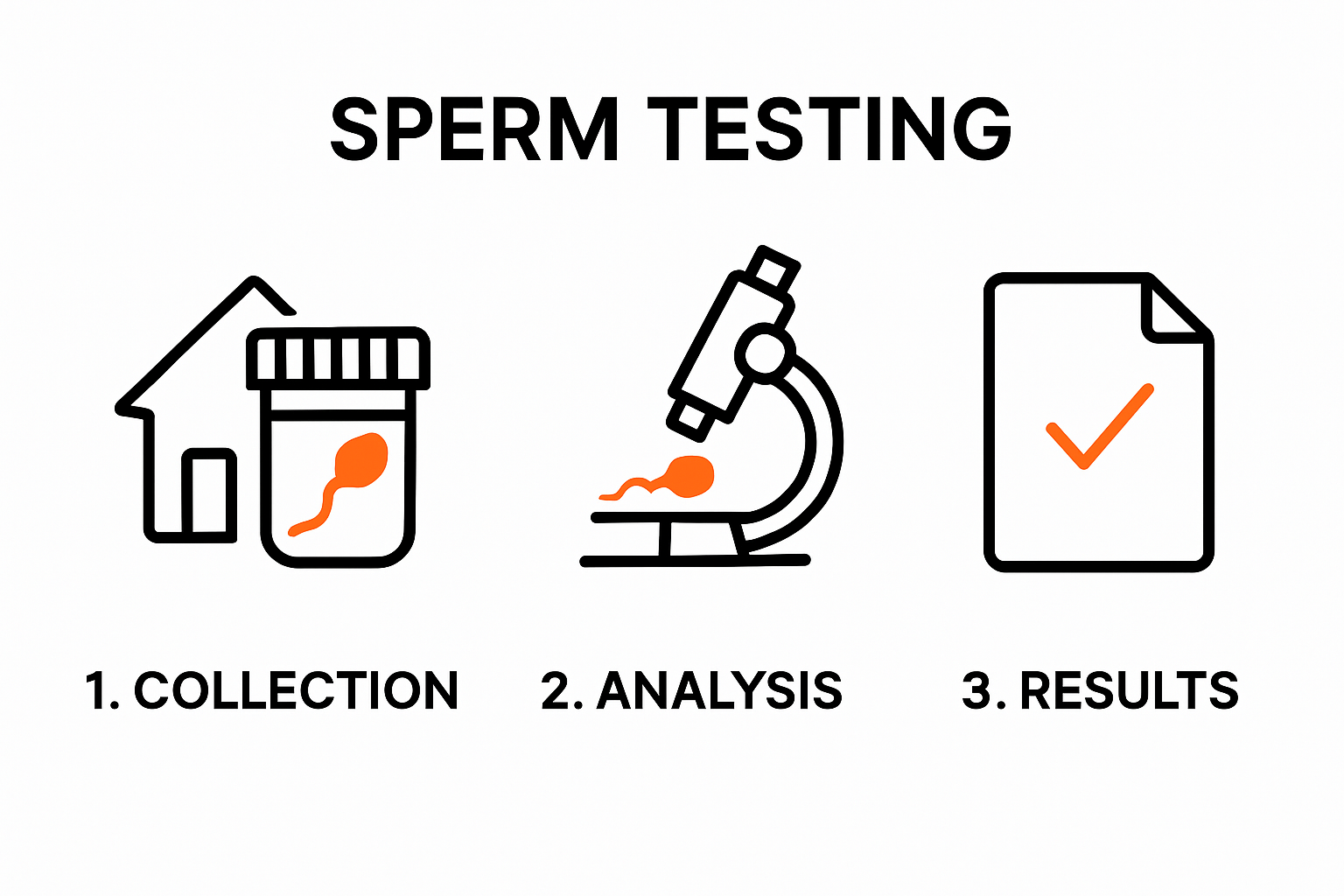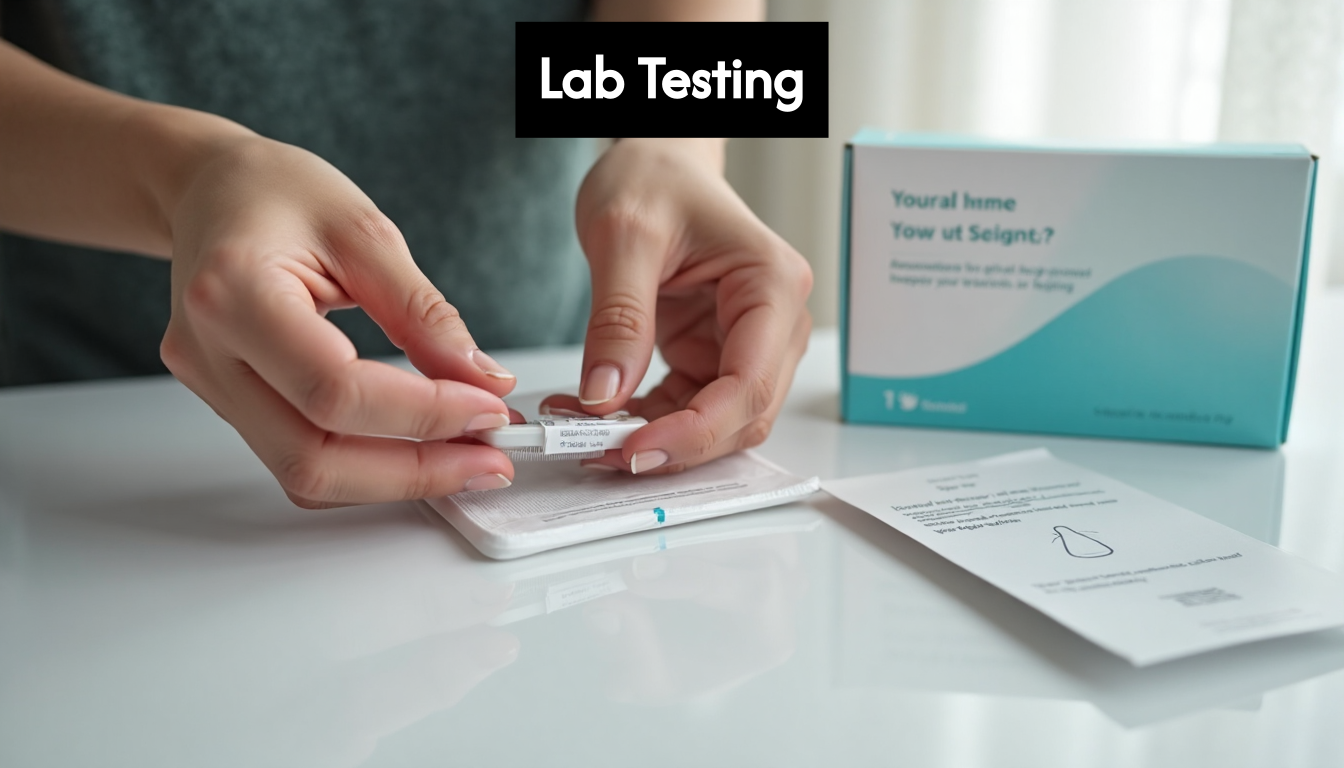Laboratory sperm testing is not just a routine checkup. After a vasectomy, men are advised to wait 8 to 12 weeks before testing because the body needs time to clear out any remaining sperm – timing is everything for accurate results. But here is where things get interesting. Modern labs do much more than just count sperm. Advanced technologies can spot invisible details, revealing potential fertility issues before they become real problems. Most assume a single test will clear things up, yet multiple analyses are often needed to guarantee long-term sterility or spot hidden risks. What shows up on those reports may surprise you.
Table of Contents
- Laboratory Sperm Testing: Vasectomy Results & Fertility In 2025
- How Laboratory Sperm Testing Works
- Sperm Testing After Vasectomy: What To Expect
- Sperm Analysis For Fertility And Conception
- Interpreting Your Sperm Test Results
Quick Summary
| Takeaway | Explanation |
|---|---|
| Timing for Testing Post-Vasectomy | Wait 8-12 weeks after vasectomy before sperm testing to ensure accurate results, as the body needs time to clear remaining sperm. |
| Understanding Test Results | Results are categorized into cleared (successful vasectomy), needs repeat testing, or potential failure, impacting next steps in patient care. |
| Advanced Analysis Techniques | Modern sperm testing employs advanced technologies for precise evaluation, including sperm count, motility, and morphology, vital for assessing reproductive health. |
| Follow-Up Testing Importance | Multiple sample analyses are recommended to confirm consistent results and ensure long-term sterility after a vasectomy. |
| Emerging Technologies in Sperm Testing | Innovations like genetic screening provide deeper insights into sperm health, helping couples navigate fertility challenges more effectively. |
How Laboratory Sperm Testing Works
Laboratory sperm testing represents a sophisticated scientific process that transforms a simple semen sample into a comprehensive fertility assessment. This meticulous procedure involves multiple precise steps designed to provide accurate insights into male reproductive health.

The Collection and Initial Processing
Sperm testing begins with careful sample collection. Unlike traditional clinical settings, modern approaches like at-home fertility testing allow men to collect specimens in the privacy and comfort of their own environment. The collection process requires strict adherence to specific guidelines to ensure sample integrity.
Once collected, the sample undergoes immediate preservation using specialized transport media. According to Cleveland Clinic, patients should abstain from sexual activity for 2-5 days before sample collection to obtain the most accurate results. This waiting period helps standardize sperm concentration and motility measurements.
Advanced Laboratory Analysis Techniques
In the laboratory, technicians employ multiple sophisticated techniques to evaluate sperm characteristics. A comprehensive semen analysis typically examines several key parameters:
- Volume Assessment: Measuring the total amount of ejaculate
- Sperm Count: Determining the total number of sperm per milliliter
- Motility Evaluation: Analyzing the percentage of moving sperm
- Morphology Analysis: Examining sperm shape and structural characteristics
For post-vasectomy testing, laboratories conduct specialized assessments. Labcorp research indicates that successful vasectomy procedures are confirmed when sperm count is below 100,000 nonmotile sperm per milliliter, or when complete azoospermia (absence of sperm) is detected.
Modern laboratory sperm testing utilizes advanced microscopic technologies and computational analysis to provide precise measurements. High-resolution imaging systems and automated counting mechanisms enable technicians to capture detailed sperm data with unprecedented accuracy. These technologies can detect subtle variations in sperm health that might indicate potential fertility challenges.
The entire process is conducted under strict clinical protocols, ensuring sample integrity and result reliability. Certified laboratories follow rigorous quality control standards, with multiple checks and balances to minimize potential errors. Technicians trained in andrology and reproductive science meticulously analyze each sample, transforming raw biological material into meaningful fertility insights.
Post-analysis, results are typically compiled into a comprehensive report detailing various sperm parameters. These reports not only provide current fertility status but can also serve as valuable diagnostic tools for understanding reproductive health. For individuals who have undergone vasectomy, these tests confirm the procedure’s effectiveness by verifying the absence of viable sperm.

By combining scientific precision with advanced technological capabilities, laboratory sperm testing offers men a powerful tool for understanding their reproductive potential. Whether confirming vasectomy success or investigating fertility concerns, these tests provide critical insights with remarkable accuracy and detail.
Sperm Testing After Vasectomy: What to Expect
Undergoing a vasectomy is a significant decision in a man’s reproductive journey, and post-procedure sperm testing plays a crucial role in confirming the procedure’s success. Understanding what to expect during this process helps patients navigate their post-vasectomy care with confidence and clarity.
Timing and Initial Recovery
After a vasectomy, patients must wait a specific period before conducting sperm testing. Cleveland Clinic recommends waiting 8-12 weeks post-procedure before collecting a semen sample. During this interval, men are advised to ejaculate multiple times to help clear remaining sperm from the reproductive system.
This waiting period is critical because immediate testing can produce misleading results. The body needs time to clear existing sperm and allow the vas deferens to completely seal. Patients should follow their urologist’s specific guidance, as individual healing rates can vary. Confirming vasectomy success requires patience and adherence to recommended protocols.
Sample Collection and Analysis
Sperm testing after a vasectomy involves a detailed examination to verify the absence of viable sperm. According to Labcorp research, successful vasectomy is confirmed when sperm count is below 100,000 nonmotile sperm per milliliter or when complete azoospermia (absence of sperm) is detected.
Patients have two primary options for sample collection:
- Clinical Collection: Traditional method involving visiting a medical facility
- At-Home Testing: Modern approach allowing private, convenient sample collection
At-home testing kits provide a discreet alternative to clinical settings. These kits include everything needed for sample collection and transportation, making the process more comfortable for patients. The sample is then sent to a certified laboratory for comprehensive analysis.
Understanding Test Results
Post-vasectomy sperm testing involves a meticulous evaluation of the semen sample. University of Cambridge Healthcare notes that a single sample can be used to clear a patient, provided strict production criteria are followed.
Test results typically fall into three categories:
- Cleared: No sperm detected, indicating successful vasectomy
- Needs Repeat Testing: Inconclusive or marginal results
- Potential Failure: Significant sperm presence suggesting procedure ineffectiveness
If initial results show the presence of sperm, patients should not panic. Follow-up testing and consultation with a urologist can provide clarity. Some men may require additional procedures or continued monitoring to ensure complete sterility.
It is essential to understand that while sperm testing provides critical information, it does not replace ongoing reproductive health management. Patients should maintain regular check-ups and communicate openly with healthcare providers about any concerns.
Modern sperm testing after vasectomy offers men a precise, scientific approach to confirming reproductive status. By understanding the process, timing, and potential outcomes, patients can approach this important health milestone with knowledge and confidence.
Sperm Analysis for Fertility and Conception
Sperm analysis represents a critical diagnostic tool for understanding male reproductive health and potential fertility challenges. This comprehensive evaluation provides crucial insights that can help couples navigate their conception journey with greater knowledge and precision.
Comprehensive Sperm Health Assessment
A detailed sperm analysis goes far beyond simple sperm counting. Modern diagnostic techniques examine multiple intricate parameters that collectively paint a comprehensive picture of male reproductive potential. Understanding semen analysis terms becomes essential for interpreting these complex results accurately.
Key parameters evaluated during comprehensive sperm analysis include:
- Sperm Count: Total number of sperm per milliliter
- Motility: Percentage of sperm capable of movement
- Morphology: Structural characteristics and shape of sperm
- Volume: Total ejaculate quantity
- pH Levels: Assessing potential biochemical barriers to fertilization
Fertility Implications and Pregnancy Potential
Sperm analysis provides critical predictive information about conception likelihood. Research published in contemporary medical journals indicates that postvasectomy pregnancy rates are remarkably low, approximately 1.97 cases per 1,000 persons annually, representing a 0.58% occurrence rate.
Multiple factors influence fertility potential beyond basic sperm metrics. Genetic quality, oxidative stress, and overall reproductive health play significant roles in successful conception. Advanced sperm testing can reveal subtle variations that traditional assessments might overlook.
Emerging Technologies in Sperm Analysis
Technological advancements are transforming sperm analysis capabilities. Cutting-edge techniques now allow for more nuanced evaluations, including genetic screening and advanced molecular assessments. These innovations provide unprecedented insights into sperm health, offering couples more comprehensive reproductive information.
Dynamic imaging technologies enable researchers to examine sperm characteristics with remarkable precision. High-resolution microscopy and computer-assisted analysis can detect microscopic variations that might impact fertility. These technologies represent a significant leap forward in understanding male reproductive potential.
Genetic screening has become increasingly sophisticated, allowing detection of potential hereditary issues that might affect sperm quality. Comprehensive genetic assessments can identify subtle chromosomal variations or mutations that traditional analyses might miss.
For couples experiencing fertility challenges, sperm analysis offers a scientific approach to understanding reproductive health. By providing detailed, objective information, these tests empower individuals to make informed decisions about family planning and potential medical interventions.
Modern sperm analysis transcends simple diagnostic testing. It represents a comprehensive approach to understanding male reproductive potential, combining advanced scientific techniques with personalized medical insights. As technology continues to evolve, these assessments will become increasingly precise, offering unprecedented clarity about fertility and reproductive health.
Interpreting Your Sperm Test Results
Sperm test results can be complex and nuanced, requiring careful interpretation to understand their full implications for reproductive health. Navigating these results demands a comprehensive approach that goes beyond simple numerical analysis.
Understanding Result Categories
Post-vasectomy sperm testing results typically fall into three primary categories. How to interpret test results for vasectomy success provides critical guidance for patients seeking clarity about their reproductive status.
Result categories include:
- Confirmed Sterility: No sperm or extremely low sperm count
- Inconclusive: Marginal sperm presence requiring follow-up
- Potential Failure: Significant sperm count indicating procedure ineffectiveness
Clinical Interpretation Standards
Labcorp research establishes clear standards for post-vasectomy semen analysis. A successful vasectomy is confirmed when:
- Total sperm count is below 100,000 nonmotile sperm per milliliter
- Complete azoospermia (absence of sperm) is detected
The American Urological Association emphasizes that patients are considered infertile after vasectomy only when at least one semen analysis demonstrates no sperm or only rare, nonmotile sperm.
Monitoring and Follow-up
Interpreting sperm test results is not a one-time event. University of Cambridge Healthcare recommends multiple sample analyses to ensure long-term sterility. Some critical considerations include:
- Repeated testing to confirm consistent results
- Understanding potential variations in sperm count
- Consulting with healthcare professionals for personalized interpretation
Patients should recognize that sperm test results represent a snapshot of reproductive health. Factors such as recent sexual activity, overall health, and individual physiological variations can influence test outcomes. A single test might not provide a comprehensive picture of reproductive status.
Advanced genetic screening and molecular analysis are increasingly becoming part of comprehensive sperm testing. These technologies offer deeper insights beyond traditional counting methods, revealing potential genetic variations or hereditary factors that might impact fertility.
For individuals who receive unexpected or concerning results, professional medical consultation is crucial. Urologists and reproductive health specialists can provide nuanced interpretations, additional testing recommendations, and potential intervention strategies.
Modern sperm testing represents more than a simple medical procedure. It is a sophisticated diagnostic tool that empowers individuals with detailed insights into their reproductive health. By understanding the complexities of test results, patients can make informed decisions about family planning, medical interventions, and overall reproductive wellness.
Remember that every set of results is unique. Professional guidance, patience, and a comprehensive approach are key to accurately interpreting and responding to sperm test findings.
Frequently Asked Questions
What is the recommended waiting period for sperm testing after a vasectomy?
Men are advised to wait 8 to 12 weeks after a vasectomy before undergoing sperm testing to ensure accurate results, as the body needs time to clear any remaining sperm.
How do laboratories analyze sperm health after a vasectomy?
Laboratories perform comprehensive analyses that include measuring sperm count, motility, and morphology. Advanced technologies allow for precise assessments, revealing potential fertility issues before they become significant problems.
What do the results of a post-vasectomy sperm test indicate?
Post-vasectomy sperm test results can fall into three categories: cleared (no sperm detected), needs repeat testing (inconclusive results), and potential failure (significant sperm presence indicating procedure ineffectiveness).
Why is follow-up testing important after the initial sperm analysis?
Follow-up testing is crucial to confirm consistent results and ensure long-term sterility after a vasectomy, as a single sample may not provide a comprehensive picture of reproductive health.





